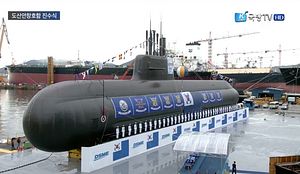South Korea has launched the first of a planned fleet of nine 3,000-ton indigenously designed KSS-III (Jangbogo–III-class) diesel-electric attack submarines at the Daewoo Shipbuilding and Marine Engineering (DSME) shipyard on Geoje Island, near the port city of Busan in the southeastern part of South Korea, on September 14.
The launch ceremony of the first-of-class KSS-III, christened Dosan Ahn Chang-ho, was attended by South Korean President Moon Jae-in and other senior government and military officials. (Watch a video of the launching ceremony here). “Peace through strengths is the unwavering security policy our government is pursuing,” Moon said. “Our path to peace will not end when accompanied by a strong military and strong defense.”
Construction of the Dosan Ahn Chang-ho began in May 2016 with final assembly periodically delayed due to various technical issues and logistical problems. The first KSS-III submarine is expected to be handed over to the Republic of Korea Navy (ROKN) by the end of 2020 or early 2021 following at least 24 months of builder sea trials. Construction costs of each sub are estimated at around $ 900 million.
“The Dosan Ahn Chang-ho submarine is the Navy’s first mid-class submarine and has been built with a combination of cutting-edge technologies,” the ROK Navy said in a press release. “This is a national strategic weapons system capable of responding to all threats, and it will help strengthen the Navy’s defense capabilities.” As I explained last month:
The entire KSS-III class of subs will be produced in three batches. The first batch will include three boats, each fitted with six vertical missile tubes with the first two submarines to be assembled by DSME and the third to be built by South Korean shipbuilder Hyundai Heavy Industries (HHI). The first three boats are expected to be operational by the early 2020s.
The next batch of three submarines, also fitted with a six-tube vertical launch system, is slated to be deployed by 2025, while the last three boats, reportedly boasting a displacement of over 3,500 tons and equipped with 10 vertical launch tubes each, will all be delivered to the ROKN by 2029. Each batch will reportedly see a gradual increase in the number of indigenous components used for the various sub-systems of the boats.
According to DSME, 76 percent of the submarine’s component parts were made in South Korea. Notably, South Korea’s Hanwha Group is supplying the sub’s combat management system, whereas its weapon handling launch system (WHLS) is being supplied by UK defense contractor Babcock with the Spanish company INDRA selected to provide its electronic defense system (ESM) PEGASO. The KSS-III subs will all be fitted with indigenous sonar systems.
Furthermore, KSS-III subs will all be equipped with air-independent propulsion powered by lithium-ion battery technology developed and built by the Hanwha Group. In addition, the boats will also be fitted with the Korean Vertical Launch System for firing land-attack and anti-ship missiles.
KSS-III boats will be the first ROKN boats to have the capability to vertically launch ballistic or cruise missiles. The Ministry’s Agency for Defense Development, or ADD, under the wing of the Defense Acquisition Program Administration, has partnered up with South Korean defense contractor LIG Nex1 to design and produce a new submarine-launched ballistic missile (SLBM) for the KSS-III class.
The new SLBM will likely be a variant of the Hyunmoo-2B or the Hyunmoo-2A. (KSS-III boats will also have the capability to fire Hyunmoo-3C cruise missiles.) As I reported elsewhere:
The Hyunmoo 2A surface-to-surface missile has an estimated range of 300 kilometers, whereas the more advanced Hyunmoo 2B — first test-fired in June 2015 — has an approximate maximum range of 500 kilometers (310 miles) and is capable of carrying a payload of up of up to 997 kilograms (2,200 pounds).
The Hyunmoo 3B and 3C surface-to-surface cruise missiles have an estimated range of 1000 and 1,500 kilometers (932 miles) respectively. While Hyunmoo cruise missiles have a higher accuracy, the destructive capability of the ballistic variant is substantially greater.
There are scarce additional details about the new SLBM. Among other things, it is unclear when it will be operationally deployed.
The new 3,000-ton KSS-III sub is 83.3-meter-long, 9.6-meter-wide, and can accommodate a crew of 50. It is capable of operating underwater without surfacing for up to 20 days. Its maximum underwater speed is estimated at 20 knots (37 kilometers per hour) with a maximum operational range of 10,000 nautical miles (18,520 kilometers). As I wrote elsewhere, the KSS-III class is part of the ROK Navy’s three-phased Korean Attack Submarine construction program launched in the 1990s:
The first phase consisted of procuring nine 1,200-ton KSS-I Chang Bogo-class diesel-electric attack submarines – a variant of German Type 209 boats. The subs of the class are currently being retrofitted with air-independent propulsion and flank-array sonars. The second phase consists of procuring nine KSS-II Son Won II-class boats, a variant of the Type 214 submarine of Germany’s Howaldtswerke-Deutsche Werft. The last sub of the KSS-II class was launched in September 2017.
Today’s launch is but one indicator this week illustrating South Korea’s emphasis on fielding more advanced anti-submarine warfare capabilities in the face of a purported growing threat posed by Korean People’s Navy (KPN) subs. Yesterday, the Department of State also approved the possible sale of six U.S.-made Boeing P-8A Poseidon maritime patrol aircraft for an estimated cost of $2.1 billion.

































